Akimel O' Odham - Pima Deep Bowl Basket - C3642A
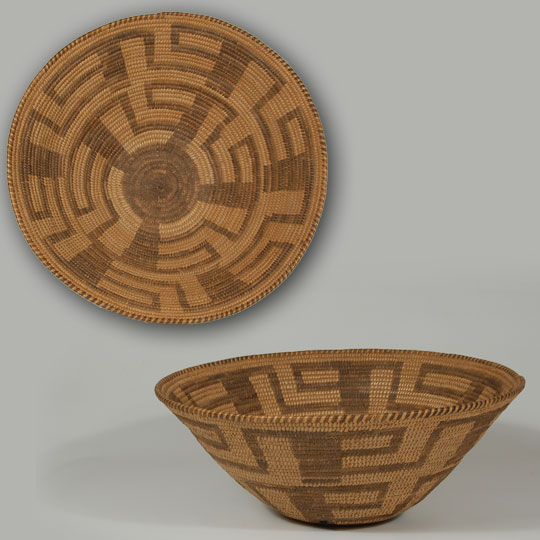 The Akimel O´Odham River People (Pima) of Arizona were major Native American basket makers in the late 19th century, primarily making them for their own use. At the turn of the century, basket weaving was being practiced in every home. This continued into the early 20th century, at which time southwest Indian basketry became a collectible commodity. The problem was that the collectors and dealers only paid $1.00 to $3.00 for a basket. The women soon realized that it was not practical to spend weeks making a basket when they could pick cotton and earn $2.00 a day. By the 1920s, basket weaving all but disappeared. By 1960, they were not even making baskets for their own use. They had, by then, substituted commercially made pots and pans for utilitarian use.
The Akimel O´Odham River People (Pima) of Arizona were major Native American basket makers in the late 19th century, primarily making them for their own use. At the turn of the century, basket weaving was being practiced in every home. This continued into the early 20th century, at which time southwest Indian basketry became a collectible commodity. The problem was that the collectors and dealers only paid $1.00 to $3.00 for a basket. The women soon realized that it was not practical to spend weeks making a basket when they could pick cotton and earn $2.00 a day. By the 1920s, basket weaving all but disappeared. By 1960, they were not even making baskets for their own use. They had, by then, substituted commercially made pots and pans for utilitarian use.
#adobegallery @Adobe Gallery -#SouthwestIndianBaskets #AkimelO'Odham #Pima
Acoma Pueblo Small Polychrome Parrot Jar by Barbara and Joe, Sr. Cerno - C3798C
Barbara Hayah Cerno (b.1951) and Merle Joseph Martin Cerno (b.1947) are a husband and wife team who sign their pottery B. J. Cerno. They make some of the largest contemporary Acoma pottery being produced today. They also have made some of the smallest, such as this olla. They have become well known for their jars decorated with parrots and rainbows. It is the style that has brought them fame.
#adobegallery @adobegallery
Black-on-red Maricopa - Peeposh Wedding Vessel - C3798B
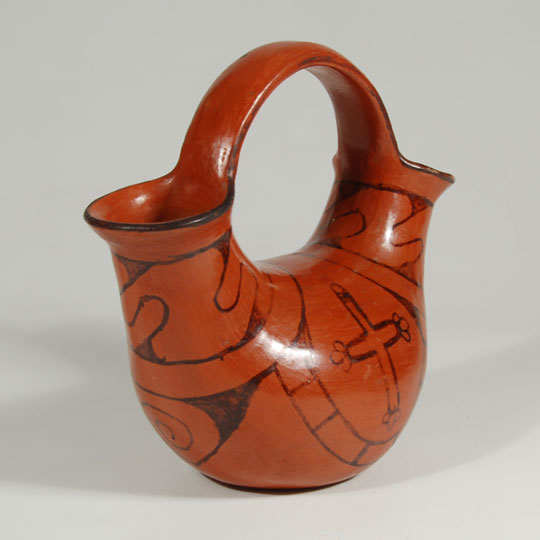 The Maricopa Reservation is located on the Salt River and Gila River regions just outside Phoenix, Arizona. There are very few Maricopa Indians remaining, and almost no potters among them. A couple of the well-known names from the past are Ida Redbird and Mable Sunn. The original name of the tribe, before the Spanish named them Maricopa, was Peeposh, a name which they are re-adopting.
The Maricopa Reservation is located on the Salt River and Gila River regions just outside Phoenix, Arizona. There are very few Maricopa Indians remaining, and almost no potters among them. A couple of the well-known names from the past are Ida Redbird and Mable Sunn. The original name of the tribe, before the Spanish named them Maricopa, was Peeposh, a name which they are re-adopting.
#adobegallery @adobegallery
Hopi Sösö’pa – Cricket Katsina Doll by James Kootshongsie - C3799A
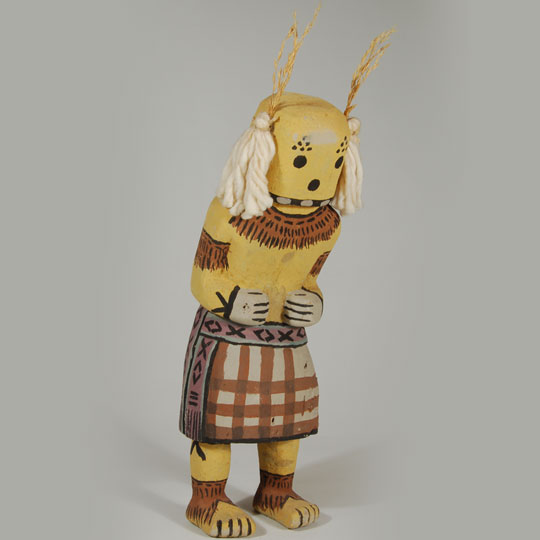 James Kootshongsie is best known as Jimmie Koots. He was born at Hopi Pueblo on the Third Mesa village of Hotevilla during the period of World War I. At a very young age, he and many other Hopi children were removed from their homes and taken to government schools where they were to be stripped of their Hopi beliefs and heritage and assimilated into the White man's culture. Koots survived the five long years at the Bureau of Indian Affairs School and then returned to his native village.
James Kootshongsie is best known as Jimmie Koots. He was born at Hopi Pueblo on the Third Mesa village of Hotevilla during the period of World War I. At a very young age, he and many other Hopi children were removed from their homes and taken to government schools where they were to be stripped of their Hopi beliefs and heritage and assimilated into the White man's culture. Koots survived the five long years at the Bureau of Indian Affairs School and then returned to his native village.
#adobegallery @adobegallery
Original Acrylic Painting “Navajo Rainbow Dance” by Harrison Begay - C3791C
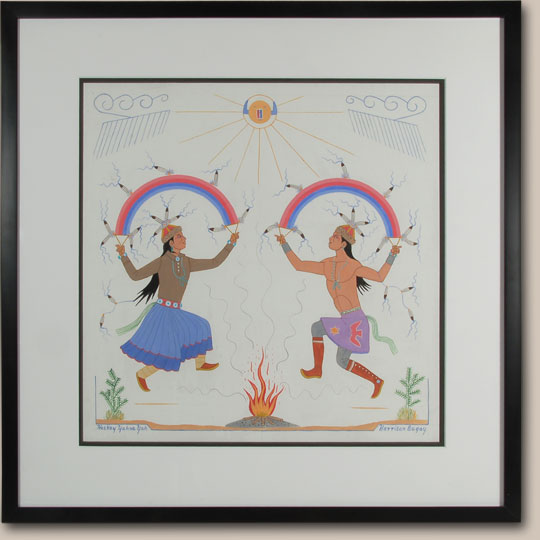 Harrison Begay was a master at capturing the beauty and harmony of everyday Navajo life. Begay painted most of his life, having been trained in the 1930s at theSanta Fe Indian School. He continued throughout his life to paint the unique aspects of Navajo life and is considered one of the most influential Native American painters. In 1951, Begay became a co-founder of Tewa Enterprises in Santa Fe, a silkscreen printing company, because he wished to make his and other Native American art available to more people by making inexpensive prints from their original art.
Harrison Begay was a master at capturing the beauty and harmony of everyday Navajo life. Begay painted most of his life, having been trained in the 1930s at theSanta Fe Indian School. He continued throughout his life to paint the unique aspects of Navajo life and is considered one of the most influential Native American painters. In 1951, Begay became a co-founder of Tewa Enterprises in Santa Fe, a silkscreen printing company, because he wished to make his and other Native American art available to more people by making inexpensive prints from their original art.
#adobegallery @adobegallery
Tesuque Pueblo Circa 1910 Rain God Figurine - C3797B
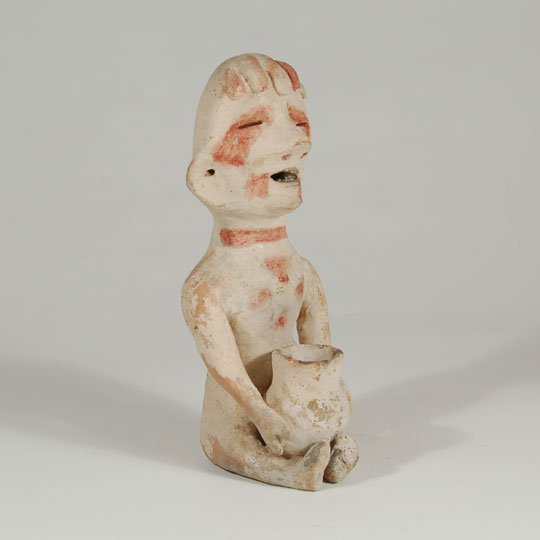 During this period, the Tesuque potters began abandoning the sole use of micaceous clay and started adding cream slip as a base coat to the rain gods. Frequently these early cream slip figurines had sculpted hair draped over the forehead and were decorated with red ink. These date to the early 1900s.
During this period, the Tesuque potters began abandoning the sole use of micaceous clay and started adding cream slip as a base coat to the rain gods. Frequently these early cream slip figurines had sculpted hair draped over the forehead and were decorated with red ink. These date to the early 1900s.
#adobegallery @adobegallery
Tesuque Pueblo Nineteenth Century Rain God Figurine - C3797A
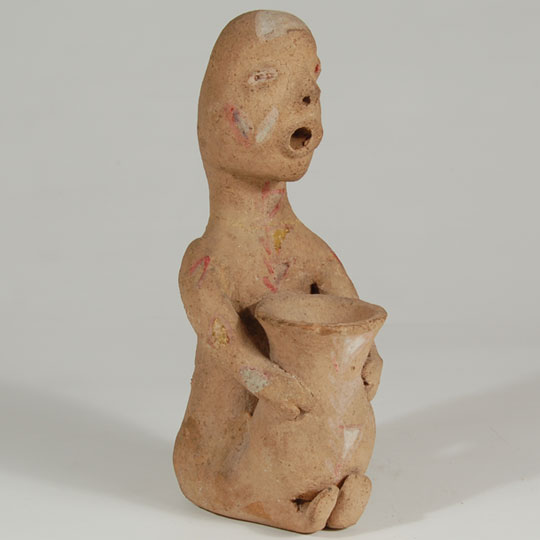 Tesuque rain gods, neither idols nor gods, were the answer and the merchants purchased them by the hundreds and thousands from the potters at Tesuque Pueblo. They were exotic and believed to be representations of idols or gods by the tourists. It is most likely that they were modeled after pre-Columbian Mexican figures of that nation's tribes. Early ones, circa 1880s, were generally made with fully exposed genitalia but later ones were made with a jar on the lap.
Tesuque rain gods, neither idols nor gods, were the answer and the merchants purchased them by the hundreds and thousands from the potters at Tesuque Pueblo. They were exotic and believed to be representations of idols or gods by the tourists. It is most likely that they were modeled after pre-Columbian Mexican figures of that nation's tribes. Early ones, circa 1880s, were generally made with fully exposed genitalia but later ones were made with a jar on the lap.
#adobegallery @adobegallery
Tesuque Pueblo Painted Rain God Figurine - C3797C
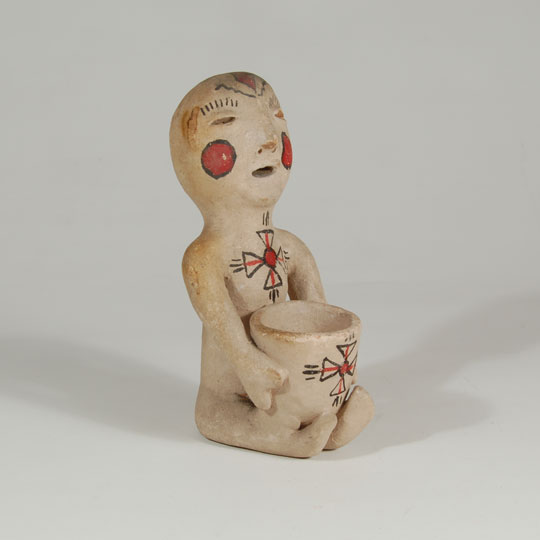 Such an explosion of visitors to Santa Fe was the impetus for a strong market for pueblo pottery. The Fred Harvey Detours took visitors directly to the pueblos to purchase pottery from the potters. Tesuque, being the closest pueblo to Santa Fe, was a favorite destination. Rain God production continued but its market became tourist visitors rather than Santa Fe merchants. Production of rain gods slowed but never ceased completely.
Such an explosion of visitors to Santa Fe was the impetus for a strong market for pueblo pottery. The Fred Harvey Detours took visitors directly to the pueblos to purchase pottery from the potters. Tesuque, being the closest pueblo to Santa Fe, was a favorite destination. Rain God production continued but its market became tourist visitors rather than Santa Fe merchants. Production of rain gods slowed but never ceased completely.
#adobegallery @adobegallery
Hopi Pueblo Black Ogre - Chaveyo Katsina Doll by Emil Pooley - C3535.67
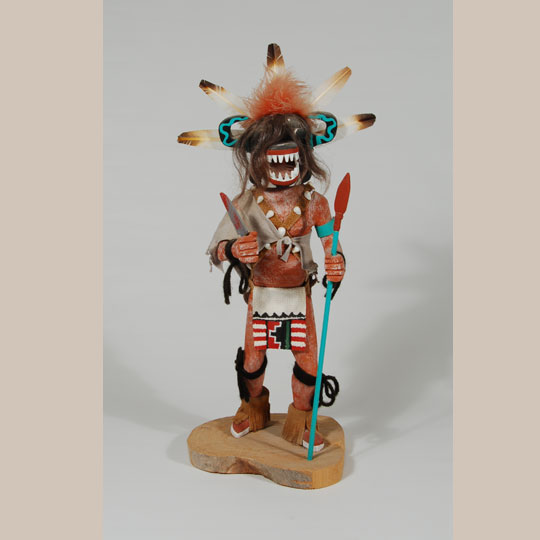 Emil Pooley (1912-1979) was a well-known carver around the Albuquerque area as he demonstrated annually at the New Mexico State Fairgrounds for years and years. After his marriage, he and his wife moved from Hotevilla Village on the Hopi Reservation, first to Winslow, AZ, then to Joseph City, AZ where they spent their remaining years. He opened a trading post in Joseph City on the old Route 66 in 1949 and continued carving katsina dolls and selling them at his post.
Emil Pooley (1912-1979) was a well-known carver around the Albuquerque area as he demonstrated annually at the New Mexico State Fairgrounds for years and years. After his marriage, he and his wife moved from Hotevilla Village on the Hopi Reservation, first to Winslow, AZ, then to Joseph City, AZ where they spent their remaining years. He opened a trading post in Joseph City on the old Route 66 in 1949 and continued carving katsina dolls and selling them at his post.
#adobegallery @adobegallery #katsinadoll
Hopi First Mesa Shalako Katsina Doll, circa 1960s - 25450
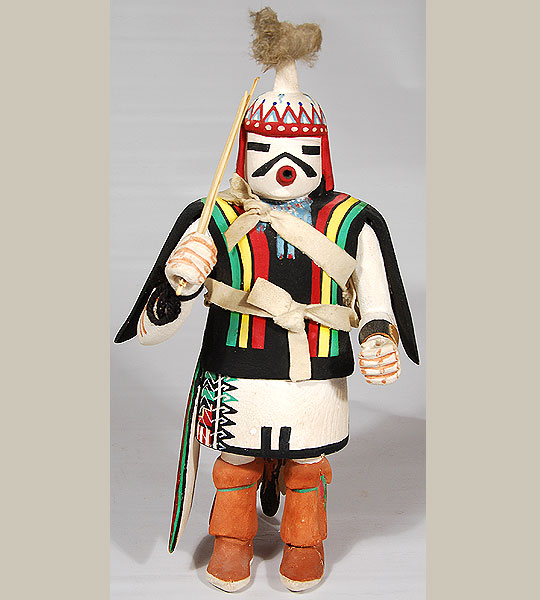 According to a Hopi Pueblo First Mesa resident, this is one of the First Mesa Hopi Shalako Katsinas who is still "danced" and, in one sense, replaces the tall Hopi Shalako who no longer dances at First Mesa because no successors have ever been appointed for them.
According to a Hopi Pueblo First Mesa resident, this is one of the First Mesa Hopi Shalako Katsinas who is still "danced" and, in one sense, replaces the tall Hopi Shalako who no longer dances at First Mesa because no successors have ever been appointed for them.
This Shalako appears only at First Mesa, and he usually is a line dancer appearing at the end of a line, who at one time accompanied the Shalako Katsinas. This Katsina is originally from the Zuni, and it is believed that this is the costume worn under the tall Shalako costume at Zuni.
#adobegallery @adobegallery
Hopi Pueblo Little River Grandfather - Tunei-nili Katsina Doll - C3535.47
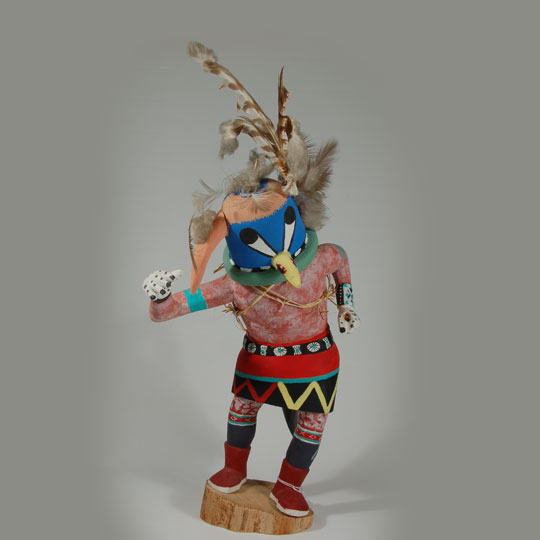 This very animated carving of Tunei-nili imparts a feeling to the viewer of a dancer in motion. The carver did an exceptional job on this Navajo-derived Katsina, who was inspired by the Navajo Rain Gods, the Tone-nili, who appear on the sixth day of the Navajo Yeibichai Ceremony, and was incorporated into the Hopi pantheon of Gods.
This very animated carving of Tunei-nili imparts a feeling to the viewer of a dancer in motion. The carver did an exceptional job on this Navajo-derived Katsina, who was inspired by the Navajo Rain Gods, the Tone-nili, who appear on the sixth day of the Navajo Yeibichai Ceremony, and was incorporated into the Hopi pantheon of Gods.
Tunei-nili has the responsibility of looking after the Navajo or Tasap Katsinas and is usually a side dancer for them. The name Tunei-nili Bitzai means "little wash" or "little river grandfather." He sometimes appears with the Velvet Shirt Katsina.
#adobegallery @adobegallery
Three Ledger Drawings of Tom Bird & Katie Hard Robe by Robert Ridge Walker - C3798E
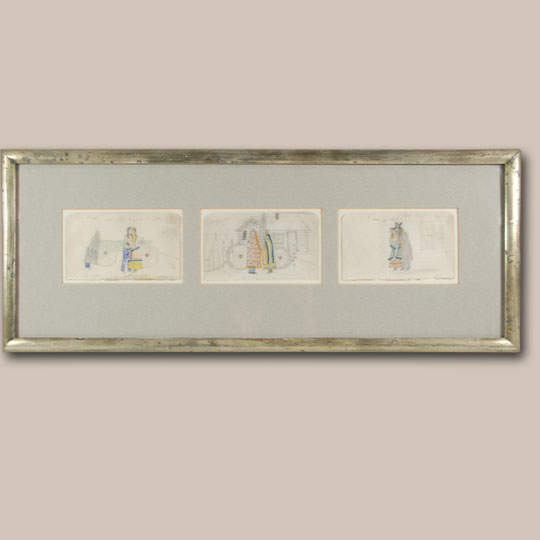 For thousands of years throughout the Great Plains, Indian artists left pictographs (paintings or drawings) and petroglyphs (carved pictures) on boulders and rock walls. Plains Indian warriors drew and painted various images on buffalo robes, teepees, and paper. Warrior art was a unique combination of art, communication tool, and record to pass down to future generations.
For thousands of years throughout the Great Plains, Indian artists left pictographs (paintings or drawings) and petroglyphs (carved pictures) on boulders and rock walls. Plains Indian warriors drew and painted various images on buffalo robes, teepees, and paper. Warrior art was a unique combination of art, communication tool, and record to pass down to future generations.
Pictures were based upon standard styles taught to young males for simplicity and better understanding by many tribes. Rather than copy what they saw, these artists captured what was important to the story by drawing the main elements, one example being an image of a warrior on his horse.
#adobegallery @adobegallery
Three Ledger Drawings of Yellowhorse by Robert Ridge Walker - C3798D
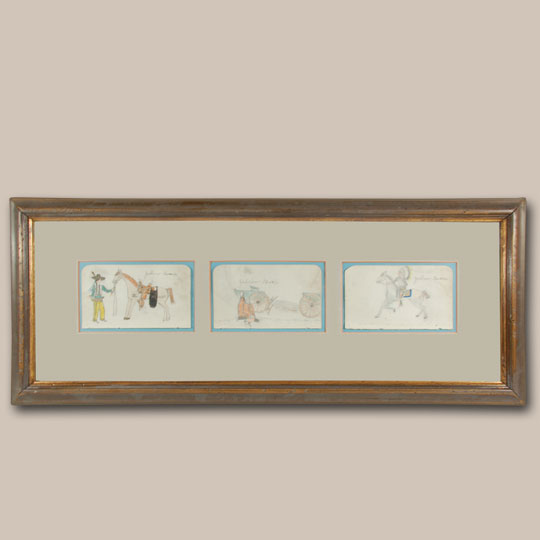 Ledger art evolved from Plains Indian hide painting. Among Plains tribes, women traditionally painted abstract, geometrical designs, whereas men painted representational designs. The men's designs were often heraldic devices or visions painted on shields, tipis, shirts, leggings, or robes. Before the Plains tribes were forced to live on reservations in the 1870s, men generally painted personal feats in battle or hunting. Plains ledger art depicted communally acknowledged events of valor and tribal importance in order to gain status for the individuals who participated in them, and their band and kin. Plains pictorial art emphasizes narrative action and eliminates unnecessary detail or backgrounds. Figures tended to be drawn in hard outlines and filled with solid fields of color.
Ledger art evolved from Plains Indian hide painting. Among Plains tribes, women traditionally painted abstract, geometrical designs, whereas men painted representational designs. The men's designs were often heraldic devices or visions painted on shields, tipis, shirts, leggings, or robes. Before the Plains tribes were forced to live on reservations in the 1870s, men generally painted personal feats in battle or hunting. Plains ledger art depicted communally acknowledged events of valor and tribal importance in order to gain status for the individuals who participated in them, and their band and kin. Plains pictorial art emphasizes narrative action and eliminates unnecessary detail or backgrounds. Figures tended to be drawn in hard outlines and filled with solid fields of color.
Navajo Petit Silver, Coral and Turquoise Squash Blossom Necklace - C3696E
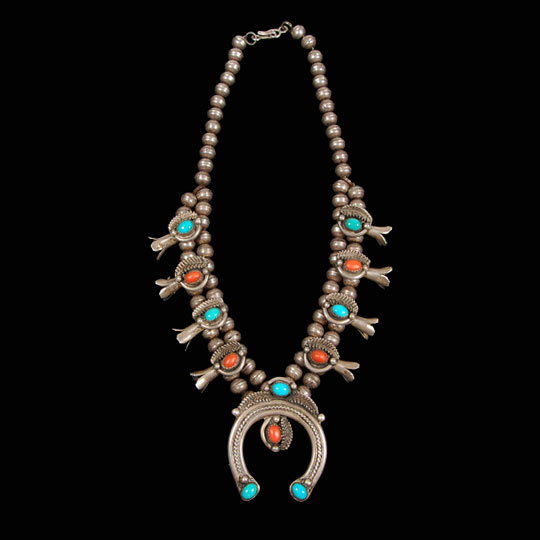 This squash blossom necklace is of a smaller size than most, a size called dainty or petit. It appears to have been made in the 1960s by a Navajo artisan named HALEY who was a silversmith working forAtkinson Trading Company of Gallup, New Mexico. Trading posts such as this would provide all the materials to smiths and then pay them for the labor costs.
This squash blossom necklace is of a smaller size than most, a size called dainty or petit. It appears to have been made in the 1960s by a Navajo artisan named HALEY who was a silversmith working forAtkinson Trading Company of Gallup, New Mexico. Trading posts such as this would provide all the materials to smiths and then pay them for the labor costs.
San Ildefonso Pueblo Black-on-Black Plate with Avanyu by Maria Martinez - C3164D
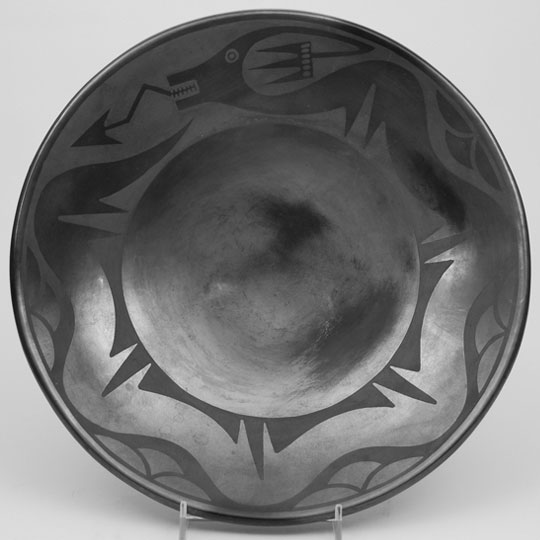 Popovi Da is best known as a collaborator with his mother, Maria Martinez. Starting in 1956, Popovi worked with Maria in all aspects of pottery preparation and their pieces were co-signed. It was his intent to assist his mother and not to take away from her attention that kept him from making pottery on his own. He was going to pursue his career after his mother was no longer making pottery. Unfortunately, he passed away in 1971. It was, at that time, that Maria retired.
Popovi Da is best known as a collaborator with his mother, Maria Martinez. Starting in 1956, Popovi worked with Maria in all aspects of pottery preparation and their pieces were co-signed. It was his intent to assist his mother and not to take away from her attention that kept him from making pottery on his own. He was going to pursue his career after his mother was no longer making pottery. Unfortunately, he passed away in 1971. It was, at that time, that Maria retired.
Black Pottery Twisted Stem Candlesticks by Margaret Tafoya - 25775
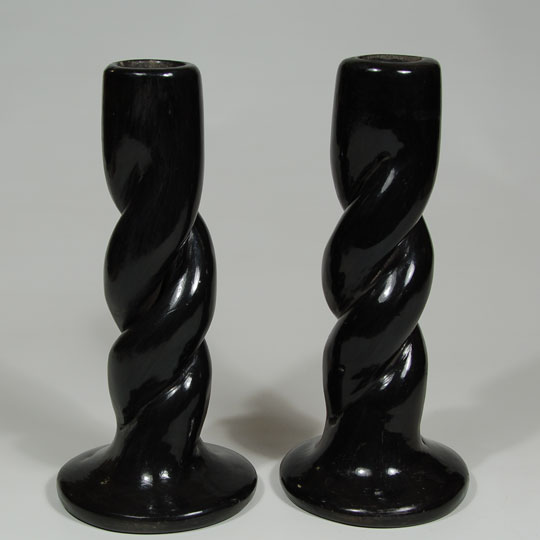 This is a superb example of a pair of black candlesticks by Margaret Tafoya. One wonders why a potter who regularly made large storage jars would spend time making what could be an insignificant item for her. There are probably many reasons but certainly a break from the routine could be high on the list. Those magnificent large jars made by Margaret day after day were very strenuous on her and a break from that routine was probably most welcome.
This is a superb example of a pair of black candlesticks by Margaret Tafoya. One wonders why a potter who regularly made large storage jars would spend time making what could be an insignificant item for her. There are probably many reasons but certainly a break from the routine could be high on the list. Those magnificent large jars made by Margaret day after day were very strenuous on her and a break from that routine was probably most welcome.
Black-on-black Jar by Crucita Gonzales Calabaza - Blue Corn - C3698
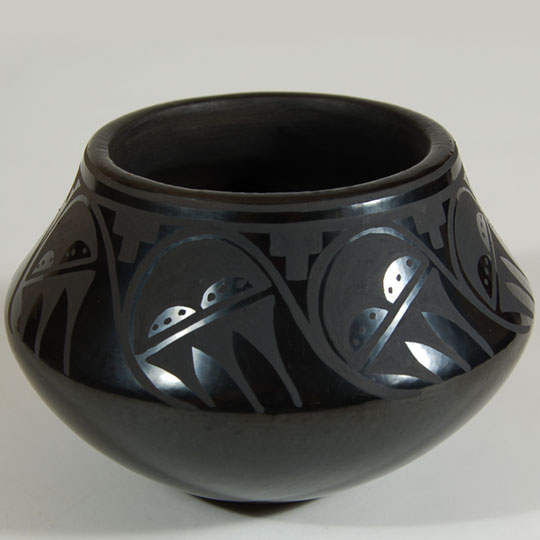 Crucita Gonzales Calabaza (1921-1999) Blue Corn was one of the greatest ceramists of all time. She made pottery for over 60 years. Her house was located across the plaza from that of Maria Martinez but there was no competition between the two artisans. She was one of the most honored of 20th century potters. She received the 1981 New Mexico Governor's Award (New Mexico's highest artistic award!) and she was acclaimed for her artistic accomplishments in the Wall Street Journal and inAMEPNKA, a Soviet Union journal. She won awards at numerous State Fairs, Santa Fe Indian Market, and other exhibitions.
Crucita Gonzales Calabaza (1921-1999) Blue Corn was one of the greatest ceramists of all time. She made pottery for over 60 years. Her house was located across the plaza from that of Maria Martinez but there was no competition between the two artisans. She was one of the most honored of 20th century potters. She received the 1981 New Mexico Governor's Award (New Mexico's highest artistic award!) and she was acclaimed for her artistic accomplishments in the Wall Street Journal and inAMEPNKA, a Soviet Union journal. She won awards at numerous State Fairs, Santa Fe Indian Market, and other exhibitions.
Red Sgraffito Seed Pot with Frog Design by Art Cody - C3771J
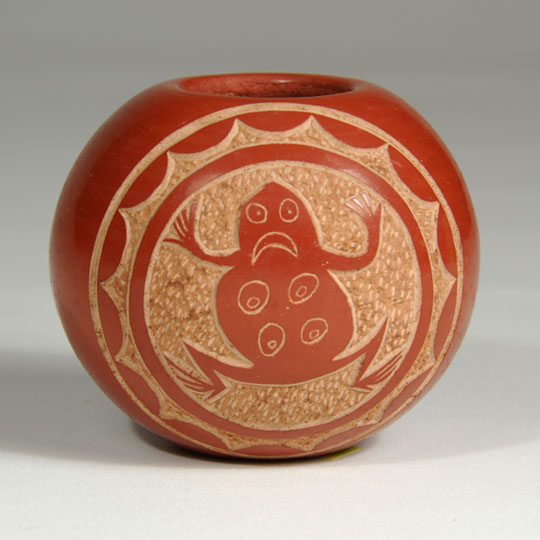 Art Cody and Martha Suazo were a young couple who married in the early 1970s. Cody was a Kiowa Indian who moved to his wife's pueblo when they married. Martha convinced her husband to help her decorate her pots, and together they created small masterpieces for a short period of time. They signed their work "Haungooah," the name of Art's grandfather who was a well-known Kiowa ledger artist and scout. Martha passed away in the late 1970s and Cody continued to make pottery on his own until his untimely passing in 1985.
Art Cody and Martha Suazo were a young couple who married in the early 1970s. Cody was a Kiowa Indian who moved to his wife's pueblo when they married. Martha convinced her husband to help her decorate her pots, and together they created small masterpieces for a short period of time. They signed their work "Haungooah," the name of Art's grandfather who was a well-known Kiowa ledger artist and scout. Martha passed away in the late 1970s and Cody continued to make pottery on his own until his untimely passing in 1985.
Red Sgraffito Seed Pot with Mimbres Grasshopper by Art Cody - C3771K
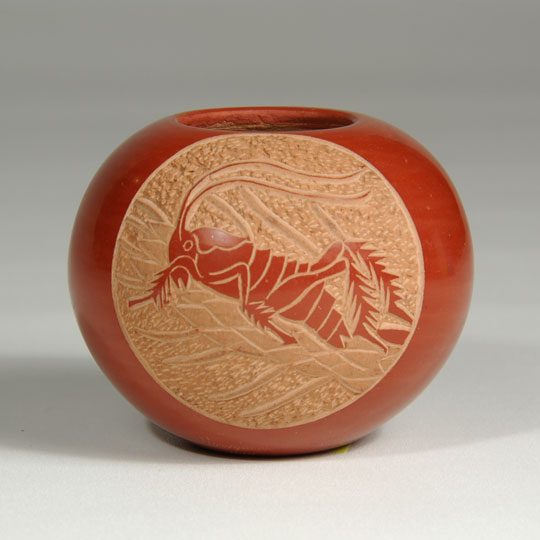 Art Cody was the grandson of famous Kiowa ledger artist Silver Horn, who was known as Haungooah, a name which means "sunlight reflecting off a buffalo horn" in the Kiowa language. Following in his grandfather's footsteps, the younger Haungooah became an innovative artist in his own right. In the late 1960s, Cody was among the first artists to use the sgraffito technique on pueblo pottery. He married a talented Santa Clara Pueblo potter, Martha Suazo, who encouraged him to decorate her pottery. Together they won numerous prizes during the 1970s. They signed their work Haungooah, after Art's grandfather. When Martha passed away sometime after 1979, he continued creating and decorating his own pieces, until his untimely death only a few years later in 1985.
Art Cody was the grandson of famous Kiowa ledger artist Silver Horn, who was known as Haungooah, a name which means "sunlight reflecting off a buffalo horn" in the Kiowa language. Following in his grandfather's footsteps, the younger Haungooah became an innovative artist in his own right. In the late 1960s, Cody was among the first artists to use the sgraffito technique on pueblo pottery. He married a talented Santa Clara Pueblo potter, Martha Suazo, who encouraged him to decorate her pottery. Together they won numerous prizes during the 1970s. They signed their work Haungooah, after Art's grandfather. When Martha passed away sometime after 1979, he continued creating and decorating his own pieces, until his untimely death only a few years later in 1985.
Red Sgraffito Seed Pot with Mimbres Rabbit by Art Cody - C3771L
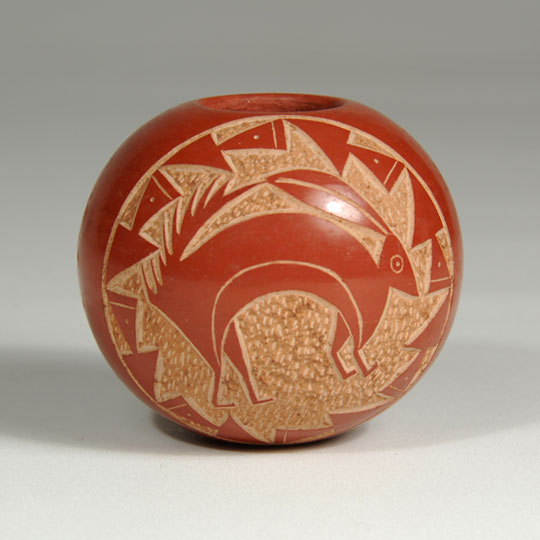 Art Cody was the grandson of Kiowa ledger artist Silver Horn. Silver Horn was born around 1860. He is best known for his fine ledger drawings of Kiowa life during the late 19th century, and is considered one of the best artists of the early reservation period. He taught and influenced family members, including Kiowa artists Stephen Mopope and Katherine Dickerson. His Kiowa name was Haungooah, which means "sunlight reflecting off a buffalo horn". Cody and his wife Martha Suazo, who were married in the early 1970s, used this name to sign their work.
Art Cody was the grandson of Kiowa ledger artist Silver Horn. Silver Horn was born around 1860. He is best known for his fine ledger drawings of Kiowa life during the late 19th century, and is considered one of the best artists of the early reservation period. He taught and influenced family members, including Kiowa artists Stephen Mopope and Katherine Dickerson. His Kiowa name was Haungooah, which means "sunlight reflecting off a buffalo horn". Cody and his wife Martha Suazo, who were married in the early 1970s, used this name to sign their work.

